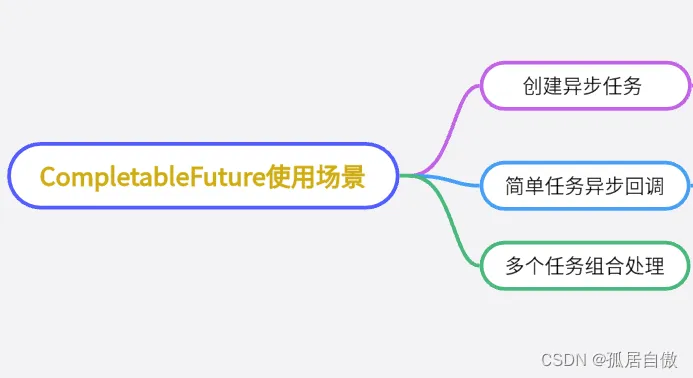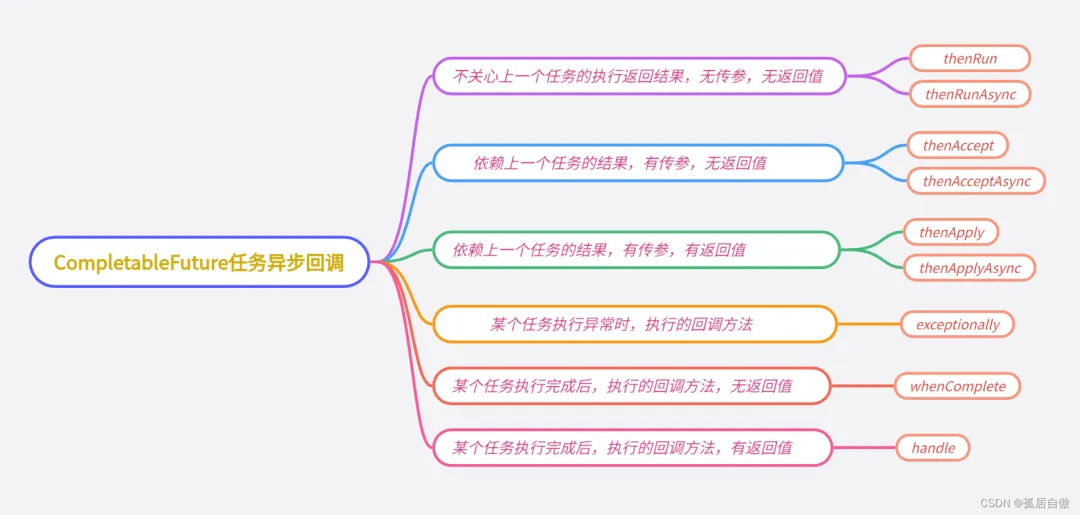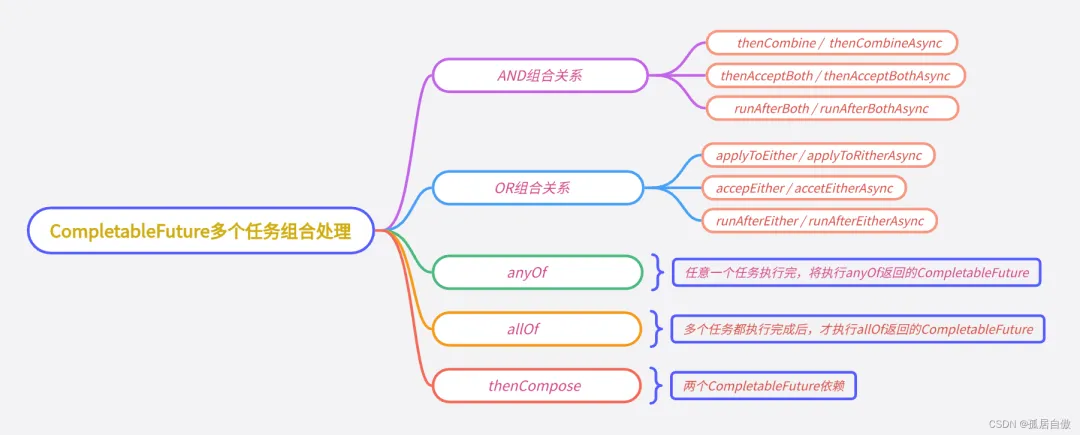前言
大多数程序员在平时工作中,都是增删改查。这里我跟大家讲解如何利用CompletableFuture优化项目代码,使项目性能更佳!
为什么要用异步编程
举个例子:用户登录成功,需要返回前端用户角色,菜单权限,个人信息,用户余额,积分情况等。正常逻辑是依次查询不同表,得到对应的数据封装返回给前端,代码如下:
@Test
public void login(Long userId){
log.info("开始查询用户全部信息---串行!");
// 查询用户角色信息
getUserRole(userId);
// 查询用户菜单信息
getUserMenu(userId);
// 查询用户余额信息
getUserAmount(userId);
// 查询用户积分信息
getUserIntegral(userId);
log.info("封装用户信息返回给前端!");
}
假如查询用户角色,用户菜单,用户余额,用户积分分别耗时500,200,200,100毫秒,则登录接口耗时为1秒。如果采用异步(多线程并行)形式,则登录接口耗时以单个查询最慢的任务为主,为查询用户角色信息500毫秒。相当于登录接口性能提升一倍!查询任务越多,则其性能提升越大!
代码演示(串行):
@Test
public void login() throws InterruptedException {
long startTime = System.currentTimeMillis();
log.info("开始查询用户全部信息!");
log.info("开始查询用户角色信息!");
Thread.sleep(500);
String role = "管理员";
log.info("开始查询用户菜单信息!");
Thread.sleep(200);
String menu = "首页,账户管理,积分管理";
log.info("开始查询查询用户余额信息!");
Thread.sleep(200);
Integer amount = 1999;
log.info("开始查询查询查询用户积分信息!");
Thread.sleep(100);
Integer integral = 1015;
log.info("封装用户信息返回给前端!");
log.info("查询用户全部信息总耗时:" + (System.currentTimeMillis() - startTime) / 1000 + "秒");
}
结果:

代码演示(异步):
@Test
public void asyncLogin() {
long startTime = System.currentTimeMillis();
log.info("开始查询用户角色信息!");
CompletableFuture<Map<String, Object>> roleFuture = CompletableFuture.supplyAsync(() -> {
try {
Thread.sleep(500);
} catch (InterruptedException e) {
e.printStackTrace();
}
Map<String, Object> roleMap = new HashMap<String, Object>();
roleMap.put("role", "管理员");
long endTime = System.currentTimeMillis();
log.info("查询用户角色信息耗时:" + (endTime - startTime) + "毫秒");
return roleMap;
});
log.info("开始查询用户菜单信息!");
CompletableFuture<Map<String, Object>> menuFuture = CompletableFuture.supplyAsync(() -> {
try {
Thread.sleep(200);
} catch (InterruptedException e) {
e.printStackTrace();
}
Map<String, Object> menuMap = new HashMap<String, Object>();
menuMap.put("menu", "首页,账户管理,积分管理");
long endTime = System.currentTimeMillis();
log.info("查询用户菜单信息耗时:" + (endTime - startTime) + "毫秒");
return menuMap;
});
log.info("开始查询用户余额信息!");
CompletableFuture<Map<String, Object>> amountFuture = CompletableFuture.supplyAsync(() -> {
try {
Thread.sleep(200);
} catch (InterruptedException e) {
e.printStackTrace();
}
Map<String, Object> amountMap = new HashMap<String, Object>();
amountMap.put("amount", 1999);
long endTime = System.currentTimeMillis();
log.info("查询用户余额信息耗时:" + (endTime - startTime) + "毫秒");
return amountMap;
});
log.info("开始查询用户积分信息!");
CompletableFuture<Map<String, Object>> integralFuture = CompletableFuture.supplyAsync(() -> {
try {
Thread.sleep(200);
} catch (InterruptedException e) {
e.printStackTrace();
}
Map<String, Object> integralMap = new HashMap<String, Object>();
integralMap.put("integral", 1015);
long endTime = System.currentTimeMillis();
log.info("查询用户积分信息耗时:" + (endTime - startTime) + "毫秒");
return integralMap;
});
roleFuture.join();
menuFuture.join();
amountFuture.join();
integralFuture.join();
log.info("查询用户全部信息总耗时:" + (System.currentTimeMillis() - startTime) + "毫秒");
}
结果:

直观的可以看出,异步执行的优势!
回顾Future
Future是什么?
- Java 1.5中引入Callable解决多线程执行无返回值的问题。
- Future是为了配合Callable/Runnable而产生的。简单来讲,我们可以通过future来对任务查询、取消、执行结果的获取,是调用方与异步执行方之间沟通的桥梁。
- FutureTask实现了RunnableFuture接口,同时具有Runnable、Future的能力,即既可以作为Future得到Callable的返回值,又可以作为一个Runnable。
- CompletableFuture实现了Futrue接口。
- Future是Java5新加的一个接口,它提供了一种异步并行计算的功能。如果主线程需要执行一个很耗时的计算任务,我们可以将这个任务通过Future放到异步线程中去执行。主线程继续处理其他任务,处理完成后,再通过Future获取计算结果。
- Future可以在连续流程中满足数据驱动的并发需求,既获得了并发执行的性能提升,又不失连续流程的简洁优雅。
代码演示(不使用自定义线程池):
@Test
public void callable() throws ExecutionException, InterruptedException {
long startTime = System.currentTimeMillis();
Callable amountCall = new Callable() {
@Override
public Object call() throws Exception {
long startTime = System.currentTimeMillis();
Thread.sleep(6000);
Map<String, Object> amountMap = new HashMap<String, Object>();
amountMap.put("amount", 99);
long endTime = System.currentTimeMillis();
log.info("查询金额信息耗时:" + (endTime - startTime) / 1000 + "秒");
return amountMap;
}
};
FutureTask<Map> amountFuture = new FutureTask<>(amountCall);
new Thread(amountFuture).start();
Callable roleCall = new Callable() {
@Override
public Object call() throws Exception {
long startTime = System.currentTimeMillis();
Thread.sleep(5000);
Map<String, String> roleMap = new HashMap<String, String>();
roleMap.put("name", "管理员");
long endTime = System.currentTimeMillis();
log.info("查询角色信息耗时:" + (endTime - startTime) / 1000 + "秒");
return roleMap;
}
};
FutureTask<Map> roleFuture = new FutureTask<>(roleCall);
new Thread(roleFuture).start();
log.info("金额查询结果为:" + amountFuture.get());
log.info("角色查询结果为:" + roleFuture.get());
long endTime = System.currentTimeMillis();
log.info("总耗时:" + (endTime - startTime) / 1000 + "秒");
}

这里要注意:Future对于结果的获取,不是很友好,只能通过阻塞或者轮询的方式得到任务的结果。
Future.get()
就是阻塞调用,在线程获取结果之前get方法会一直阻塞;Future提供了一个isDone方法,可以在程序中轮询这个方法查询执行结果。
这里的 amountFuture.get() 如果放到如下图所示的位置,则amountFuture下面的线程将等 amountFuture.get() 完成后才能执行,没有执行完,则一直阻塞。

结果:

代码演示(使用自定义线程池):
@Test
public void executor() throws ExecutionException, InterruptedException {
long startTime = System.currentTimeMillis();
ExecutorService executor = Executors.newFixedThreadPool(2);
Callable amountCall = new Callable() {
@Override
public Object call() throws Exception {
long startTime = System.currentTimeMillis();
Thread.sleep(6000);
Map<String, Object> amountMap = new HashMap<String, Object>();
amountMap.put("amount", 99);
long endTime = System.currentTimeMillis();
log.info("查询金额信息耗时:" + (endTime - startTime) / 1000 + "秒");
return amountMap;
}
};
Callable roleCall = new Callable() {
@Override
public Object call() throws Exception {
long startTime = System.currentTimeMillis();
Thread.sleep(5000);
Map<String, String> roleMap = new HashMap<String, String>();
roleMap.put("name", "管理员");
long endTime = System.currentTimeMillis();
log.info("查询用户角色信息耗时:" + (endTime - startTime) / 1000 + "秒");
return roleMap;
}
};
Future amountFuture = executor.submit(amountCall);
Future roleFuture = executor.submit(roleCall);
log.info("金额查询结果为:" + amountFuture.get());
log.info("角色查询结果为:" + roleFuture.get());
long endTime = System.currentTimeMillis();
log.info("总耗时:" + (endTime - startTime) / 1000 + "秒");
}
结果:

CompletableFuture使用场景

创建异步任务

CompletableFuture创建异步任务,一般有supplyAsync和runAsync两个方法:
- supplyAsync执行CompletableFuture任务,支持返回值。
- runAsync执行CompletableFuture任务,没有返回值。
supplyAsync方法
//使用默认内置线程池ForkJoinPool.commonPool(),根据supplier构建执行任务
public static <U> CompletableFuture<U> supplyAsync(Supplier<U> supplier)
//自定义线程,根据supplier构建执行任务
public static <U> CompletableFuture<U> supplyAsync(Supplier<U> supplier, Executor executor)
runAsync方法
//使用默认内置线程池ForkJoinPool.commonPool(),根据runnable构建执行任务
public static CompletableFuture<Void> runAsync(Runnable runnable)
//自定义线程,根据runnable构建执行任务
public static CompletableFuture<Void> runAsync(Runnable runnable, Executor executor)
代码演示:
@Test
// supplyAsync执行CompletableFuture任务,支持返回值
public void defaultSupplyAsync() throws ExecutionException, InterruptedException {
long startTime = System.currentTimeMillis();
// 构建执行任务
CompletableFuture<Map<String, Object>> amountCompletableFuture = CompletableFuture.supplyAsync(() -> {
try {
Thread.sleep(6000);
} catch (InterruptedException e) {
e.printStackTrace();
}
Map<String, Object> amountMap = new HashMap<String, Object>();
amountMap.put("amount", 99);
long endTime = System.currentTimeMillis();
log.info("查询金额信息耗时:" + (endTime - startTime) / 1000 + "秒");
return amountMap;
});
// 这行代码在这里 则会进行6秒的阻塞 下面代码其他线程无法创建
// 只能等这个线程6秒过后结束才能创建其他线程
// Map<String, Object> userMap = userCompletableFuture.get();
CompletableFuture<Map<String, Object>> roleCompletableFuture = CompletableFuture.supplyAsync(() -> {
try {
Thread.sleep(5000);
} catch (InterruptedException e) {
e.printStackTrace();
}
Map<String, Object> roleMap = new HashMap<String, Object>();
roleMap.put("name", "管理员");
return roleMap;
});
log.info("金额查询结果为:" + amountCompletableFuture.join());
log.info("角色查询结果为:" + roleCompletableFuture.join());
log.info("总耗时:" + (System.currentTimeMillis() - startTime) / 1000 + "秒");
}
@Test
// supplyAsync执行CompletableFuture任务,支持返回值
public void customSupplyAsync() throws ExecutionException, InterruptedException {
// 自定义线程池
ExecutorService executorService = Executors.newCachedThreadPool();
long startTime = System.currentTimeMillis();
CompletableFuture<Map<String, Object>> amountCompletableFuture = CompletableFuture.supplyAsync(() -> {
try {
Thread.sleep(6000);
} catch (InterruptedException e) {
e.printStackTrace();
}
Map<String, Object> amountMap = new HashMap<String, Object>();
amountMap.put("amount", 99);
long endTime = System.currentTimeMillis();
log.info("查询金额信息耗时:" + (endTime - startTime) / 1000 + "秒");
return amountMap;
}, executorService);
// 这行代码在这里 则会进行6秒的阻塞 下面代码其他线程无法创建
// 只能等这个线程6秒过后结束才能创建其他线程
// Map<String, Object> userMap = userCompletableFuture.get();
CompletableFuture<Map<String, Object>> roleCompletableFuture = CompletableFuture.supplyAsync(() -> {
try {
Thread.sleep(5000);
} catch (InterruptedException e) {
e.printStackTrace();
}
Map<String, Object> roleMap = new HashMap<String, Object>();
roleMap.put("name", "管理员");
return roleMap;
}, executorService);
log.info("金额查询结果为:" + amountCompletableFuture.join());
log.info("角色查询结果为:" + roleCompletableFuture.join());
// 线程池需要关闭
executorService.shutdown();
log.info("总耗时:" + (System.currentTimeMillis() - startTime) / 1000 + "秒");
}
@Test
// runAsync执行CompletableFuture任务,没有返回值
public void defaultRunAsync() {
long lordStartTime = System.currentTimeMillis();
CompletableFuture<Void> amountCompletableFuture = CompletableFuture.runAsync(() -> {
long startTime = System.currentTimeMillis();
try {
Thread.sleep(3000);
} catch (InterruptedException e) {
e.printStackTrace();
}
log.info("执行金额增删改操作用时:" + (System.currentTimeMillis() - startTime) / 1000 + "秒");
});
CompletableFuture<Void> roleCompletableFuture = CompletableFuture.runAsync(() -> {
long startTime = System.currentTimeMillis();
try {
Thread.sleep(4000);
} catch (InterruptedException e) {
e.printStackTrace();
}
log.info("执行角色增删改操作用时:" + (System.currentTimeMillis() - startTime) / 1000 + "秒");
});
log.info("金额查询结果为:" + amountCompletableFuture.join());
log.info("角色查询结果为:" + roleCompletableFuture.join());
log.info("总耗时:" + (System.currentTimeMillis() - lordStartTime) / 1000 + "秒");
}
@Test
// runAsync执行CompletableFuture任务,没有返回值
public void customRunAsync() {
long lordStartTime = System.currentTimeMillis();
ExecutorService executor = Executors.newCachedThreadPool();
CompletableFuture<Void> amountCompletableFuture = CompletableFuture.runAsync(() -> {
long startTime = System.currentTimeMillis();
try {
Thread.sleep(2000);
} catch (InterruptedException e) {
e.printStackTrace();
}
log.info("执行金额增删改操作用时:" + (System.currentTimeMillis() - startTime) / 1000 + "秒");
}, executor);
CompletableFuture<Void> roleCompletableFuture = CompletableFuture.runAsync(() -> {
long startTime = System.currentTimeMillis();
try {
Thread.sleep(1000);
} catch (InterruptedException e) {
e.printStackTrace();
}
log.info("执行角色增删改操作用时:" + (System.currentTimeMillis() - startTime) / 1000 + "秒");
}, executor);
log.info("金额查询结果为:" + amountCompletableFuture.join());
log.info("角色查询结果为:" + roleCompletableFuture.join());
// 关闭线程池
executor.shutdown();
log.info("总耗时:" + (System.currentTimeMillis() - lordStartTime) / 1000 + "秒");
}
注意:这里的get()与join()都是获取任务线程的返回值。
-
join()方法抛出的是uncheck异常(即RuntimeException),不会强制开发者抛出,
会将异常包装成CompletionException异常 /CancellationException
异常,但是本质原因还是代码内存在的真正的异常; -
get()方法抛出的是经过检查的异常,
ExecutionException,InterruptedException
需要用户手动处理(抛出或者 try catch)。
异步任务回调

thenRun / thenRunAsync
CompletableFuture的thenRun方法,通俗点讲就是,做完第一个任务后,再做第二个任务。某个任务执行完成后,执行回调方法;但是前后两个任务没有参数传递,第二个任务也没有返回值。
public CompletableFuture<Void> thenRun(Runnable action);
public CompletableFuture<Void> thenRunAsync(Runnable action);
thenRun / thenRunAsync的区别? 源码解释:
private static final Executor asyncPool = useCommonPool ?
ForkJoinPool.commonPool() : new ThreadPerTaskExecutor();
public CompletableFuture<Void> thenRun(Runnable action) {
return uniRunStage(null, action);
}
public CompletableFuture<Void> thenRunAsync(Runnable action) {
return uniRunStage(asyncPool, action);
}
如果你执行第一个任务的时候,传入了一个自定义线程池:
- 调用thenRun方法执行第二个任务时,则第二个任务和第一个任务是共用同一个线程池。
- 调用thenRunAsync执行第二个任务时,则第一个任务使用的是你自己传入的线程池,第二个任务使用的是ForkJoin线程池。
后面介绍的thenAccept和thenAcceptAsync,thenApply和thenApplyAsync等,它们之间的区别也是这个哈!
代码演示:
@Test
// 执行第一个任务后 可以继续执行第二个任务 两个任务之间无传参 无返回值
public void defaultThenRun() throws ExecutionException, InterruptedException {
long lordStartTime = System.currentTimeMillis();
CompletableFuture<Void> amountCompletableFuture = CompletableFuture.runAsync(() -> {
long startTime = System.currentTimeMillis();
try {
Thread.sleep(2000);
} catch (InterruptedException e) {
e.printStackTrace();
}
log.info("执行金额增删改操作用时:" + (System.currentTimeMillis() - startTime) / 1000 + "秒");
});
CompletableFuture<Void> thenCompletableFuture = amountCompletableFuture.thenRun(() -> {
long startTime = System.currentTimeMillis();
try {
Thread.sleep(1000);
} catch (InterruptedException e) {
e.printStackTrace();
}
log.info("执行角色增删改操作用时:" + (System.currentTimeMillis() - startTime) / 1000 + "秒");
});
thenCompletableFuture.get();
log.info("总耗时:" + (System.currentTimeMillis() - lordStartTime) / 1000 + "秒");
}
结果:

thenAccept / thenAcceptAsync
CompletableFuture的thenAccept方法表示,第一个任务执行完成后,执行第二个回调方法任务,会将该任务的执行结果,作为入参,传递到回调方法中,但是回调方法是没有返回值的。
public CompletableFuture<Void> thenAccept(Consumer<? super T> action);
public CompletableFuture<Void> thenAcceptAsync(Consumer<? super T> action);
代码演示:
@Test
// 执行第一个任务后 可以继续执行第二个任务 并携带第一个任务的返回值 第二个任务执行完没有返回值
public void defaultThenAccept() throws ExecutionException, InterruptedException {
long lordStartTime = System.currentTimeMillis();
CompletableFuture<Map> amountCompletableFuture = CompletableFuture.supplyAsync(() -> {
long startTime = System.currentTimeMillis();
try {
Thread.sleep(2000);
} catch (InterruptedException e) {
e.printStackTrace();
}
Map<String, Object> amountMap = new HashMap<String, Object>();
amountMap.put("amount", 90);
log.info("执行金额查询操作用时:" + (System.currentTimeMillis() - startTime) / 1000 + "秒");
return amountMap;
});
CompletableFuture<Void> thenCompletableFuture = amountCompletableFuture.thenAccept((map) -> {
long startTime = System.currentTimeMillis();
if (Integer.parseInt(map.get("amount").toString()) > 90) {
try {
Thread.sleep(1000);
} catch (InterruptedException e) {
e.printStackTrace();
}
log.info("金额充足,可以购买!:" + (System.currentTimeMillis() - startTime) / 1000 + "秒");
} else {
log.info("金额不足,无法购买!:" + (System.currentTimeMillis() - startTime) / 1000 + "秒");
}
});
thenCompletableFuture.get();
log.info("总耗时:" + (System.currentTimeMillis() - lordStartTime) / 1000 + "秒");
}
结果:

thenApply / thenApplyAsync
CompletableFuture的thenApply方法表示,第一个任务执行完成后,执行第二个回调方法任务,会将该任务的执行结果,作为入参,传递到回调方法中,并且回调方法是有返回值的。
public <U> CompletableFuture<U> thenApplyAsync();
public CompletableFuture<Void> thenAccept(Consumer<? super T> action);
代码演示:
@Test
// 执行第一个任务后 可以继续执行第二个任务 并携带第一个任务的返回值 第二个任务执行完有返回值
public void defaultThenApply() throws ExecutionException, InterruptedException {
long lordStartTime = System.currentTimeMillis();
CompletableFuture<Map> amountCompletableFuture = CompletableFuture.supplyAsync(() -> {
long startTime = System.currentTimeMillis();
try {
Thread.sleep(2000);
} catch (InterruptedException e) {
e.printStackTrace();
}
Map<String, Object> amountMap = new HashMap<String, Object>();
amountMap.put("amount", 90);
log.info("执行金额查询操作用时:" + (System.currentTimeMillis() - startTime) / 1000 + "秒");
return amountMap;
});
CompletableFuture<Integer> thenCompletableFuture = amountCompletableFuture.thenApply((map) -> {
int number = 0;
if (Integer.parseInt(map.get("amount").toString()) > 3) {
try {
Thread.sleep(1000);
} catch (InterruptedException e) {
e.printStackTrace();
}
// 可口可乐3元一瓶 看金额一共能购买多少瓶
number = Integer.parseInt(map.get("amount").toString()) / 3;
}
return number;
});
log.info("当前金额一共可以买" + thenCompletableFuture.get() + "瓶可口可乐!");
Integer integer = thenCompletableFuture.get();
log.info("总耗时:" + (System.currentTimeMillis() - lordStartTime) / 1000 + "秒");
}
结果:

exceptionally
CompletableFuture的exceptionally方法表示,某个任务执行异常时,执行的回调方法;并且有抛出异常作为参数,传递到回调方法。
public CompletableFuture<T> exceptionally(
Function<Throwable, ? extends T> fn) {
return uniExceptionallyStage(fn);
}
代码演示:
@Test
// 某个任务执行异常时,执行的回调方法;并且有抛出异常作为参数,传递到回调方法。
public void exceptionally() throws ExecutionException, InterruptedException {
long lordStartTime = System.currentTimeMillis();
CompletableFuture<Map> amountCompletableFuture = CompletableFuture.supplyAsync(() -> {
long startTime = System.currentTimeMillis();
try {
Thread.sleep(2000);
} catch (InterruptedException e) {
e.printStackTrace();
}
Map<String, Object> amountMap = new HashMap<String, Object>();
amountMap.put("amount", 90);
log.info("执行金额查询操作用时:" + (System.currentTimeMillis() - startTime) / 1000 + "秒");
return amountMap;
});
CompletableFuture<Integer> thenCompletableFuture = amountCompletableFuture.thenApply((map) -> {
int number = 0;
if (Integer.parseInt(map.get("amount").toString()) > 3) {
try {
Thread.sleep(1000);
// 可口可乐3元一瓶 看金额一共能购买多少瓶
number = Integer.parseInt(map.get("amount").toString()) / 0;
} catch (ArithmeticException | InterruptedException e) {
e.printStackTrace();
throw new ArithmeticException(); // 这里一定要将异常抛除了,不然exceptionally无效
}
}
return number;
});
CompletableFuture<Integer> exceptionFuture = thenCompletableFuture.exceptionally((e) -> {
log.error("除数为0,则默认商为0!");
return 0;
});
log.info("当前金额一共可以买" + thenCompletableFuture.get() + "瓶可口可乐!");
exceptionFuture.get();
log.info("总耗时:" + (System.currentTimeMillis() - lordStartTime) / 1000 + "秒");
}

注意:这里的异常一定要抛出来,不然exceptionally无效!
whenComplete
CompletableFuture的whenComplete方法表示,某个任务执行完成后,执行的回调方法,无返回值;并且whenComplete方法返回的CompletableFuture的result是上个任务的结果。
public CompletableFuture<T> whenComplete(
BiConsumer<? super T, ? super Throwable> action) {
return uniWhenCompleteStage(null, action);
}
代码演示:
@Test
// 某个任务执行完成后,执行的回调方法,无返回值;并且whenComplete方法返回的CompletableFuture的result是上个任务的结果。
public void whenComplete() {
CompletableFuture<String> stringCompletableFuture = CompletableFuture.supplyAsync(() -> {
return "周杰伦";
});
CompletableFuture<String> stringCompletableFuture1 = stringCompletableFuture.whenComplete((a, throwable) -> {
log.info("周杰伦喜欢唱");
});
log.info("输出结果为第一个任务:" + stringCompletableFuture1.join());
}
结果:

handle
CompletableFuture的handle方法表示,某个QQ账号买号平台地图任务执行完成后,执行回调方法,并且是有返回值的;并且handle方法返回的CompletableFuture的result是回调方法执行的结果。
public <U> CompletableFuture<U> handle(
BiFunction<? super T, Throwable, ? extends U> fn) {
return uniHandleStage(null, fn);
}
代码演示:
@Test
// 某个任务执行完成后,执行的回调方法,有返回值;并且handle方法返回的CompletableFuture的result是第二个任务的结果。
public void handle() {
CompletableFuture<String> stringCompletableFuture = CompletableFuture.supplyAsync(() -> {
return "周杰伦";
});
CompletableFuture<String> stringCompletableFuture1 = stringCompletableFuture.handle((a, throwable) -> {
return "周杰伦喜欢唱歌!";
});
log.info("输出结果为第二个任务:" + stringCompletableFuture1.join());
}
结果:

多个任务组合处理

AND组合关系
thenCombine / thenAcceptBoth /
runAfterBoth都表示:将两个CompletableFuture组合起来,只有这两个都正常执行完了,才会执行某个任务。
- thenCombine:会将两个任务的执行结果作为方法入参,传递到指定方法中,且有返回值。
- thenAcceptBoth: 会将两个任务的执行结果作为方法入参,传递到指定方法中,且无返回值。
- runAfterBoth 不会把执行结果当做方法入参,且没有返回值。
代码演示:
@Test
public void thenCombine() {
CompletableFuture<Integer> first = CompletableFuture.supplyAsync(() -> {
return 7;
});
CompletableFuture<Integer> second = CompletableFuture.supplyAsync(() -> 2).thenCombine(first, Integer::sum);
log.info("结果为:" + second.join());
}
结果为:

OR组合关系
applyToEither / acceptEither / runAfterEither
都表示:将两个CompletableFuture组合起来,只要其中一个执行完了,就会执行某个任务。
- applyToEither:会将已经执行完成的任务,作为方法入参,传递到指定方法中,且有返回值。
- acceptEither: 会将已经执行完成的任务,作为方法入参,传递到指定方法中,且无返回值。
- runAfterEither:不会把执行结果当做方法入参,且没有返回值。
代码演示:
@Test
public void applyToEither1() {
log.info("魏凯下班准备回家。。。");
log.info("魏凯等待2号,4号地铁。。。");
CompletableFuture<String> busCF = CompletableFuture.supplyAsync(() -> {
log.info("2号在路上。。。");
try {
Thread.sleep(3000);
} catch (InterruptedException e) {
e.printStackTrace();
}
return "2";
}).applyToEither(CompletableFuture.supplyAsync(() -> {
log.info("4号地铁在路上。。。");
try {
Thread.sleep(4000);
} catch (InterruptedException e) {
e.printStackTrace();
}
return "4";
}), first -> first + "号");
log.info("魏凯坐上" + busCF.join() + "地铁");
}
@Test
// OR
public void applyToEither() {
CompletableFuture<Integer> first = CompletableFuture.supplyAsync(() -> {
try {
Thread.sleep(2000L);
} catch (InterruptedException e) {
e.printStackTrace();
}
return 7;
});
CompletableFuture<Integer> second = CompletableFuture.supplyAsync(() -> {
try {
Thread.sleep(3000L);
} catch (InterruptedException e) {
e.printStackTrace();
}
return 7;
}).applyToEither(first, num -> num);
log.info("最后结果为:" + second.join());
}
结果演示:

AllOf
所有任务都执行完成后,才执行
allOf返回的CompletableFuture。如果任意一个任务异常,allOf的CompletableFuture,执行get方法,会抛出异常。
代码演示:
@Test
// 所有任务都执行完成后,才执行 allOf返回的CompletableFuture。如果任意一个任务异常,allOf的CompletableFuture,执行get方法,会抛出异常。
// 这里第一次执行没有睡眠的话,是可以直接执行第三个任务的。如果有睡眠,则需要手动join启动。
public void allOf() {
CompletableFuture<Void> first = CompletableFuture.runAsync(() -> {
// try {
// Thread.sleep(2000);
// } catch (InterruptedException e) {
// e.printStackTrace();
// }
log.info("第一个任务执行完成!");
});
CompletableFuture<Void> second = CompletableFuture.runAsync(() -> {
// try {
// Thread.sleep(500);
// } catch (InterruptedException e) {
// e.printStackTrace();
// }
log.info("第二个任务执行完成!");
});
CompletableFuture<Void> voidCompletableFuture = CompletableFuture.allOf(first, second).whenComplete((m, n) -> {
log.info("第三个任务完成!");
});
// voidCompletableFuture.join();
}
结果:

注意:这里第一次启动执行没有睡眠的话,是可以直接执行第三个任务的,因为这两个任务都执行完成,启动的瞬间第三个也同时执行完。如果有睡眠,则需要手动join启动,等待最长睡眠任务时间过后,第三个任务完成!
AnyOf
任意一个任务执行完,就执行anyOf返回的CompletableFuture。如果执行的任务异常,anyOf的CompletableFuture,执行get方法,会抛出异常。
代码演示:
@Test
// 前提任务任意执行完一个,则目标任务执行。其他前提任务则不在执行。
// 任意一个任务执行完,就执行anyOf返回的CompletableFuture。如果执行的任务异常,anyOf的CompletableFuture,执行get方法,会抛出异常。
public void anyOf() {
CompletableFuture<Void> first = CompletableFuture.runAsync(() -> {
try {
Thread.sleep(2000);
} catch (InterruptedException e) {
e.printStackTrace();
}
log.info("第一个任务执行完成!");
});
CompletableFuture<Void> second = CompletableFuture.runAsync(() -> {
try {
Thread.sleep(500);
} catch (InterruptedException e) {
e.printStackTrace();
}
log.info("第二个任务执行完成!");
});
CompletableFuture<Object> voidCompletableFuture = CompletableFuture.anyOf(first, second).whenComplete((m, n) -> {
log.info("第三个任务完成!");
});
voidCompletableFuture.join();
}
结果:

thenCompose
thenCompose方法会在某个任务执行完成后,将该任务的执行结果,作为方法入参,去执行指定的方法。该方法会返回一个新的CompletableFuture实例。
- 如果该CompletableFuture实例的result不为null,则返回一个基于该result新的CompletableFuture实例。
- 如果该CompletableFuture实例为null,然后就执行这个新任务。
代码演示:
@Test
public void thenCompose1() {
CompletableFuture<Integer> stringCompletableFuture = CompletableFuture.supplyAsync(() -> 4)
.thenCompose(value -> CompletableFuture.supplyAsync(() -> {
// thenCompose方法返回一个新的CompletableFuture
if (Integer.valueOf(4).equals(value)) {
return 66;
} else {
return 99;
}
}));
log.info("结果:" + stringCompletableFuture.join());
}
@Test
public void thenCompose() {
CompletableFuture<String> first = CompletableFuture.completedFuture("第一个任务");
CompletableFuture<String> stringCompletableFuture = CompletableFuture.supplyAsync(() -> 4)
.thenCompose((data) -> {
log.info("data为:" + data);
return first;
});
log.info("结果:" + stringCompletableFuture.join());
}
结果:

CompletableFuture注意点

Future需要获取返回值,才能获取异常信息
@Test
public void futureTest(){
ExecutorService executor = Executors.newFixedThreadPool(2);
CompletableFuture<Integer> integerCompletableFuture = CompletableFuture.supplyAsync(() -> {
int m = 9;
int n = 0;
return m / n;
},executor);
// integerCompletableFuture.join(); // 这行代码不加,则不会抛出异常
}
Future需要获取返回值,才能获取到异常信息。如果不加
get()/join()方法,看不到异常信息。小伙伴们使用的时候,注意一下哈,考虑是否加try…catch…或者使用exceptionally方法。
CompletableFuture的get()方法是阻塞的
//反例
CompletableFuture.get();
//正例
CompletableFuture.get(9, TimeUnit.SECONDS);
CompletableFuture的get()方法是阻塞的,如果使用它来获取异步调用的返回值,需要添加超时时间
默认线程池的注意点
CompletableFuture代码中又使用了默认的线程池,处理的线程个数是电脑CPU核数-1。在大量请求过来的时候,处理逻辑复杂的话,响应会很慢。一般建议使用自定义线程池,优化线程池配置参数。
自定义线程池时,注意饱和策略
CompletableFuture的get()方法是阻塞的,我们一般建议使用 future.get(3, TimeUnit.SECONDS)
。并且一般建议使用自定义线程池。但是如果线程池拒绝策略是DiscardPolicy或者DiscardOldestPolicy,当线程池饱和时,会直接丢弃任务,不会抛弃异常。
因此建议,CompletableFuture线程池策略最好使用AbortPolicy,然后耗时的异步线程,做好线程池隔离!
来源:blog.csdn.net/qq_43372633/article/details/130814200






















 1005
1005











 被折叠的 条评论
为什么被折叠?
被折叠的 条评论
为什么被折叠?










